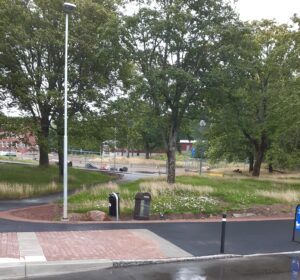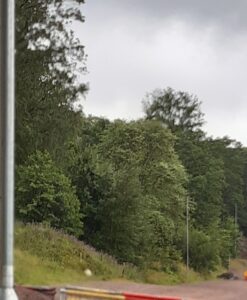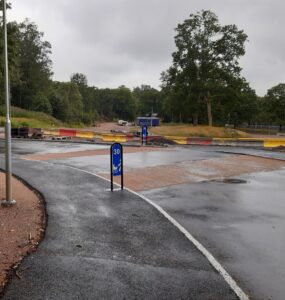We are all steeped in cultural heritage, perhaps several, and it should be as obvious to talk about cultural heritage as about class, ethnicity, gender, religion, etcetera. Or absence of cultural heritage: Displacement.
Ruins in the landscape, the foundations of houses and old earth cellars become pictures in the mind, (and a memorial) and knowledge turns them into stories; mostly stories that have been told by others and ones that we have expanded on ourselves. This is a broader understanding of the context in which I find myself. A few weeks ago, my reading about Scottish heaths and crofts brought to mind images of the heather moors from the area where I grew up. The article I was reading was called “Hardscrabble Heritage:The Ruined Black House and Crofting Landscape as Heritage from below”and was written by archaeologist Iain James McPherson Robertson, who also wrote the book “Heritage from Below” (2012).
I remember the foundations of the hand labourer house, which disappeared for good some time in the 1990s. It feels like I am part of that story just by having gone through the rubble, the revealing debris, by reading working class writers such as Moa Martinsson, Ivar Lo-Johansson and others. I am part of a larger movement that swept through Sweden. I have seen the remains of eroded away activity and until then almost forgotten practices such as drying hay and thatching. I have roamed around the district, which later became an urban municipality, to which I moved when I was seven. I have absorbed that place, that landscape. Got them under my skin, made them mine. It is a feeling and something I ‘just know’. I do not have to doubt it, even if some people would argue the opposite.
My “Mad heritage” is equally unquestionable. It is important that I do not let anyone take it away from me, but that I get to know myself and my ‘co-mads’ from both the past and the present, and that they, like me, can understand who we are; what traditions and regulations have governed and ‘dictated’ existence in the mental hospitals to which we have been admitted and which people have shown us care and compassion in the midst of all the routines. Like a mental health nurse who, when I said that it was clear to see that I was medicated, hugged me and said that it wasn’t at all, although we both knew it was. But it was her way of giving me encouragement and making me feel trust in the world and people outside the walls of the mental hospital. However, I feel that it is not a ‘heritage’ that should be allowed to define me or make up my identity. It’s part of the whole picture, but a part that can make me stronger. And when I read Iain Robertson’s article with the dialogue between him and one of those who still owns a run-down ‘black house’[1], a stone cabin, something in it, perhaps benevolence, an ethos, reminds me of the conversation between researcher Elisabeth Punzi and me as we walked around the Lillhaga district, visited the culverts and Hökälla Green work and Rehab. The following is a small example of the dialogue between the questioner Robertson (Q) and his informant or respondent (R). We clearly see how much emotion is contained in what Robertson calls ‘memory traces’ (Robertson, 2015:13). And it is also obvious that we need the “traces” to remember, because they provide support for memory (ibid:1,3).
“Q: […], or was it more than that?
- It was more than that, yes.
Q: And are you able to say more than that?
Q: Yes, you feel it in here.
R: Aye… the old house is falling down. Every single person that’s related to me wants me to knock it down, get it together. And I have been resisting.” (ibid:14–15)
Without Elizabeth’s questions and interest, my relationship with Lillhagen and the other mental hospitals I had been in remained ‘diffuse’ and would have continued to give me an unpleasant feeling in the stomach. By clarifying my relationship with these sites and learning more, I am better equipped to take an active part in my cultural heritage, not least by critically examining it.
When I returned to Lillhagen at the beginning of July and walked my bike up the road leading into the area, I was greeted by large empty spaces, it felt so desolate: Just me and a couple of solitary strollers in the summer evening.
The author and professor of ethnology, Lars-Eric Jönsson, put his finger on what is missing in emptiness:
“Sick people, criminals, those in care, outsiders and society’s way of treating such people with institutions and repressive legislation, or the ability of local communities to sometimes embrace, sometimes reject non-conformists, should be more clearly present in terms of cultural heritage.” (Jönsson, 2017:13).
I know, of course, that the areas are to be built up, and it remains to be seen what will remain/reflect the former hospital setting. Or whether Lillhagen Hospital, and everyone who once resided here in different roles, has already been sent to the scrap heap of history by the city of Gothenburg. Robertson talks about the (Black house) story as a kind of lifeline to the present, and that if we cut it, only ‘ghostly echoes’ remain.
“Where the broken black house remains present it does so as an entity performed through, in which every day bodily engagements speak of, perform tasks and conjure up affective jolts. Where the ruin is no longer physically present, their absence then speaks of a form of ghostly haunting. Thus, present-day […] practices and tasks carry with them ghostly echoes and memories of previous practices and tasks.” (Roberson, 2015:19)
I cycled past the red brick houses, they will soon be all that can reveal anything about the institutional life that was here. Except for the centuries-old oaks that are protected by a tree preservation order[2]. Within me, I know that I am in the process of ‘picking up’ some of the echoes, figuratively speaking, that have not yet gained a ghostly tone, unlike the practices and the story that I have experienced and understood. Anything to move on. Because, to paraphrase Robertson, it is impossible to distinguish my stays here from any other affective influences that shape an individual’s sense of self.
/Helena Lindbom
References:
Jönsson, L-E. (red). (2017). Politiska projekt, osäkra kulturarv. En inledning (sid. 7-21) i Politiska projekt, osäkra kulturarv. ( Lunds universitet. Lunds Studies in Arts and Cultural Sciences 14.
Robertson, McPherson, I. J. Hardscrabble Heritage: The Ruined Blackhouse and Crofting Landscape as Heritage from below. In Landscape of Heritage and Heritage Landscapes, volume 40, 2015- issue 8. Published online: 28 October, 2015, sid. 1-30. Hämtad: 2020-07-03.
Robertson, J.M. (2012) (red). Heritage from below. UK. Ashgate.
Öhrstedt, B. (2015). Nu jämnas Lillhagens sjukhus med marken. SVT Nyheter. 2015-08-12.
[1] Se Blackhouse museum, undiscoveredscotland.co.uk. “Black house” ruiner beskrivs också som stenstugor från vilka torpare fördrevs”. Se fr.tripadvisor.ch/LocationPhotoDirect
[2] Se SVT Nyheters artikel ”Nu jämnas Lillhagens sjukhus med marken” skriven av journalisten Bernhard Öhrstedt. Den är publicerad: 2015-08-12.



We need something to help us remember, something that brings memories to life. Our memories are usually “embedded” in something material, if only a ruin of, for example, a former home or a glade where we often went. Translated from Robertson (2012).
Photos: Helena Maria
